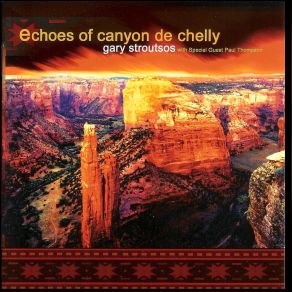Echoes of Canyon de Chelly
Download links and information about Echoes of Canyon de Chelly by Gary Stroutsos. This album was released in 2002 and it belongs to New Age, World Music genres. It contains 17 tracks with total duration of 51:35 minutes.

|
|
|---|---|
| Artist: | Gary Stroutsos |
| Release date: | 2002 |
| Genre: | New Age, World Music |
| Tracks: | 17 |
| Duration: | 51:35 |
| Buy it NOW at: | |
| Buy on iTunes $9.99 | |
Tracks
[Edit]| No. | Title | Length |
|---|---|---|
| 1. | Gentle Navajo (Lodge Ruin) | 4:11 |
| 2. | Canyon Squirrel Prologue I | 0:20 |
| 3. | Zuni Sunrise (Traditional Zuni) [feat. Paul Thompson] | 3:27 |
| 4. | People of the Willows (Ledge Ruin) | 3:37 |
| 5. | Cherished Grandmother (Dakotah Trad.) Ledge Ruin | 4:15 |
| 6. | Zuni Coming in Song (Zuni Trad.) White House Ruin (featuring Paul Thompson) | 2:11 |
| 7. | Lost Bird (White House Ruin) | 3:10 |
| 8. | Song for Oshanee (White House Ruin) | 2:27 |
| 9. | Along the River (Hidastsa Trad.) White House Ruin | 2:16 |
| 10. | Taos Pueblo Courting Love Song (Taos Trad.) White House Ruin | 3:50 |
| 11. | Cottonwoods At Canyon del Muerto Improvosation | 2:59 |
| 12. | Cottonwoods At Canyon del Muerto Improvisation (feat. Paul Thompson) | 4:53 |
| 13. | Ledge Birds / Shi Ni Sha (Traditional Navajo) [Ledge Ruin] (featuring Paul Thompson) | 5:17 |
| 14. | Zuni Comanche Dance Song (Traditional) [feat. Paul Thompson] | 3:24 |
| 15. | In Home God's Fields (Ledge Ruin) | 3:19 |
| 16. | Echoes of Canyon de Chelly (Ledge Ruin) | 1:37 |
| 17. | Canyon Squirrel Prologue II | 0:22 |
Details
[Edit]The atmospheric new age flutist is a purist in the sense that he favors recording his regional concept projects in the places he "paints" his meditative, impressionistic music. Here, he makes sure his listeners are flute enthusiasts, daring to go 50 whole minutes conveying different moods, emotions, and Southwest locations with only his flute and that of Navajo artist and flutemaker Paul Thompson. There are some echo parts done by other flutists as well. The disc is best enjoyed while reading the extensively illustrated booklet, which includes a brief history of the Navajos in the Canyon de Chelly region, a musical travelogue essay by Stroutsos, explanations of each tune's inspiration, and beautiful photos. The 17 tracks are arranged in four movements named after the places where they were recorded: Ledge Ruin, White House Ruin, Cottonwoods at Canyon del Muerto (improvisations by Stroutsos and Thompson), and Return to Ledge Ruin. To those who love this kind of music, it's something to treasure, a very rich musical landscape. For those uninitiated, it's too stark a production to make good driving music and can become somewhat repetitive without any driving rhythms. There's no question, however, that it's an ambitious labor of love.